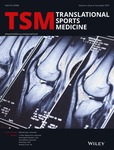Association between hamstring flexibility and lumbopelvic posture and kinematics during ergometer rowing
Abstract
Restricted pelvic range of motion leading to extreme flexion of the lumbar spine during rowing has been associated with higher loads within the spine and therefore may contribute to low back pain. It is further indicated that tight hamstrings have a negative influence on the rowing posture. In this study, the relationships between hamstring flexibility and lumbopelvic kinematics during ergometer rowing in 17 male adolescent rowers were examined. Hamstring flexibility was assessed using the passive knee extension test, and lumbopelvic kinematics was assessed via flexible sensor strips at the back and pelvis. No associations were found between hamstring flexibility and pelvic kinematics during rowing (RoM: P > .18, r = .35 and angle at catch: P > .48, r = .19), suggesting that there is no relevant influence of hamstring flexibility on lumbopelvic kinematics in adolescent male rowers. Therefore, techniques to increase hamstring flexibility might be ineffective in low back pain prevention and rehabilitation. In contrast, years of rowing experience showed a strong effect on lumbar RoM (P < .01, r = −.726) and a weak effect on pelvic motions (P < .04, r = .542), suggesting that the level of technical skills is of more important matter.
CONFLICT OF INTEREST
There is no conflict of interest.




